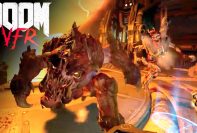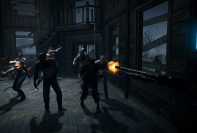Bethesda’s Fallout 4 VR is a game that takes the series’ best elements and grafts them onto a virtual reality experience. It’s not perfect, but it’s worth playing if you’re interested in checking out the future of gaming on this platform
The millennium falcon vr is a virtual reality game that takes the player into a post-apocalyptic world. The player can explore, fight, and even build settlements.

The birds are singing, your kid, Shaun, is secure in his crib, and Codsworth is in the kitchen cooking something. It’s the same opening we’ve watched a million times in the normal version of Fallout 4, but this time I’m standing in the center of my virtual reality room, with everything that isn’t nailed down pushed aside and out of sight.
There will be radiation poisoning (we can’t get enough Fancy Lad Snack Cakes), scavenging (we need all we can obtain for colonies), and a whole lot of pain in this remade Commonwealth. Here’s our take on Fallout 4 VR.
In relation to this review
We’ve spent enough time in-game to evaluate the mechanics and playability, therefore we’re writing this review after that. We’ll concentrate on how the game functions in VR and how effectively it’s been recreated for the platform, rather than the primary Fallout 4 narrative and numerous side missions – no DLC material is included — since they haven’t changed.
Fallout 4’s virtual reality gameplay mechanics

Fallout 4 is a complicated game with a lot happening on at all times, so turning it into a usable VR experience was no small feat. While the general mechanics take a little getting accustomed to, it plays nicely overall. Your controllers (no virtual hands here) are always active, regardless of what you’re holding, and instructions may become mixed up with all the trash surrounding the environment. You won’t inadvertently smack Preston Garvey in the face with your laser musket a second time with the accuracy that comes from playing the game for a long. I also made my virtual wands include pointing sticks, which made it lot simpler to pick up and start discussions.
Various modes of movement

Locomotion was one of the most talked-about issues leading up to the release of Fallout 4 VR. Will we be able to travel freely or will we have to rely on teleport? Bethesda has decided to let the player make the final decision.
Teleportation is the default method of mobility. To bring up an arc and landing place, squeeze the trigger on your left Vive wand. You may go as far as you like as long as you don’t teleport too far at once. Only if you teleport too far will you lose Action Points (AP), the number that also applies to the Vault-Tec Assisted Targeting System (V.A.T.S.). Teleporting is the fastest method to get across the globe, although it detracts from immersion somewhat.
Smooth movement is the most engaging method to walk about, and I didn’t feel any pain even without the movement fade turned on.
The game’s Settings menu now contains a “VR” section with settings for locomotion, Pip-Boy, and movement fade (translucent borders that suck in to prevent nausea). Smooth movement may be selected here, which is controlled by the touchpad on the left Vive wand. Simply tap the direction you wish to travel to begin moving. Your character will travel quicker if you click, but your AP meter will be depleted. Smooth movement is the most engaging method to walk about, and I didn’t feel any pain even without the movement fade turned on.
I could easily spin my body since my setup was in a big space with nothing in my way. The wand’s touchpad does, however, include a snap-turn feature. Those who don’t have the ability to turn physically should have no trouble playing Fallout 4 VR in one direction, and I don’t see why you wouldn’t be able to sit down and enjoy the game.
Melee weapons are a kind of melee weapon.
The security baton, a short, thin smashing stick, is the first piece of gear you get your hands on in Fallout 4 VR. The first radroaches you come across are near to the ground, and you’ll find yourself hunched over crushing them to death. It would be exhausting if all melee confrontations were like this, but fortunately, most opponents are standing erect, ready to take a pounding at eye level.
Melee weapons, like firearms, are controlled by a single controller, no matter how big a sledgehammer you discover. Swinging your controller and seeing a head fall off is a sickening pleasure, and tracking is standard with the Vive. Going with a pure melee build would be a lot of fun, but after a few hours of gameplay, I found myself leaning toward firearms since it was simpler to maintain track of enemies from afar. Taking on big numbers of opponents up close in VR may be daunting, particularly when there are multiples utilizing melee weapons. You seem to be able to stop oncoming melee strikes, although it isn’t always effective.
Gunplay
After playing a few other Vive titles, like Pavlov VR and Breach It, it’s obvious that carrying weapons with two hands works well in VR, yet guns in Fallout 4 VR are handled in one hand owing to button-mapping restrictions. Even the minigun is included.

The majority of your time here will be spent shooting things, and Bethesda did an excellent job with it. When shooting, you hold your controller at a natural angle, and reloading requires a press of the grips. It seemed a little corny to hold the bigger weapons with one hand, but I soon got over it. Simply act as though you’re John Rambo.
Scopes do not functioning right now. Not at all. Wait till Bethesda publishes a patch or two if you want to play Fallout 4 VR simply to become a kickass stealth sniper assassin.
Crafting and settlements
One of the most significant differences between Fallout 4 and its first-person predecessors was the ability to convert all of your gathered trash into crafting materials and refashion it into armor, weapons, and settlement goods. The menus have been updated to fit the Vive wands, and all of the crafting and settlement-building capabilities have been retained.

I expected the crafting menus to be even more difficult after navigating the Pip-Boy. They are, however, extremely neatly spread out over both wands. It took me about 30 seconds to adjust, and then I was constructing and scraping as quickly as I did in the normal game. Because the touchpad is utilized for the menu, the smooth movement you may be enjoying while constructing your colonies may be disrupted. Instead, teleportation is utilized.
VR immersion and improvements in Fallout 4

There isn’t much more to say about Fallout 4 VR except that it is extremely immersive. As you prowl the wasteland, the creaks and moans of decaying structures surrounding you, the snarls and groans of ghouls around the corner, and the chatter of adversaries laying in wait will send chills up your spine. If you like the regular Fallout 4, you’ll enjoy this one much more. Changes to support VR seem to have been limited to a bare minimum, with the most of them in place to enable the transition from keyboard and mouse to Vive wands.
The first thing you’ll notice about VR is how few character customization choices there are. There’s no way to go back to a third-person perspective as there is in Skyrim VR, so there’s no need for a lot of choices. Instead, there are just a few settings from which to select.
If you like the regular Fallout 4, you’ll enjoy this one much more.
The basic game’s computer terminals were a source of considerable irritation for players who were trapped when trying to seat down. When entering a terminal, instead of moving the VR view around, we’re given a black backdrop with flashing green text superimposed. It’s a quick and easy cure for any nausea-inducing movement.
Lockpicking in VR works on the reverse principle, with a tiny lock picture appearing above the safe or door rather than taking up the majority of the screen as in the normal game. Instead of moving the bobby pin by swiping left or right on the touchpad and twisting the screwdriver by pressing the trigger, you move the bobby pin by swiping left or right on the touchpad. It works, and now that I’ve played the game, I can see how precise lockpicking motions with the wands would be too difficult to master.

By default, your Pip-Boy is visible at all times and is placed on your virtual wrist. To use it, just raise your arm in front of your face, and it expands to make it easier to read. This is an awesome element that contributes to the realism, however I found it a little tough to manage, particularly in battle. It was less immersive but functioned better after altering it to be accessible by touching the center of the touchpad and utilizing it as a normal menu. Using the Vive wand touchpad to navigate the Pip-Boy menus takes some getting used to, and it may be difficult until you get the hang of it, but it seems Bethesda done a decent job compressing a keyboard and mouse down to the wands.
Finally, V.A.T.S. is the VR update I’m most excited about. Rather of halting time, you’re immersed in a slow-motion scenario that depletes your AP meter. Body parts may be highlighted by pointing at them, making precise shots a breeze. It’s gratifying to score headshots in real life, but landing four in a row in V.A.T.S. is borderline excessive.

The majority of the other minor changes to the control system and how the game works go undetected while you’re enjoying the wasteland. This is a positive thing since it means you can enjoy the game without having to worry about skipping sections because something didn’t transfer properly to VR.
Performance and visuals in Fallout 4 VR

My first foray into Fallout 4 VR required approximately two hours of uninterrupted gameplay. The gameplay drew me in, and I had fun exploring about and getting accustomed to the controls and fighting. The visuals seemed to have taken a blow, but there was nothing to write home about.
During my break, I started reading online comments about the game’s fuzzy visuals, which had rendered it unusable. This seems to be related to your desktop’s DPI and scaling. There are already a slew of possible solutions floating around, and Bethesda is undoubtedly investigating the problem. The game does seem to be less fuzzy after trying out some of these changes on my personal setup, but I’m looking forward to seeing anything official to see how the game is intended to look.
Bethesda has issued a beta update that addresses the blurriness that many players were experiencing. The Steam Fallout 4 VR News page has full patch details and instructions for installing the fix. The visuals are considerably improved in the game after the patch, although some players are still experiencing problems.

Aside from scaling and DPI issues, Fallout 4 VR runs well on an NVIDIA GTX 1080, 16GB of RAM, and an Intel Core i7-7700K CPU. There were a few hops to the SteamVR gridscape for a fast load between key parts of the narrative, but overall, load times were swift and there was very little twitching and tearing.
Bugs are common in Bethesda games, and you’ll almost certainly encounter a few while you play. Over the course of many hours, I crashed to desktop numerous times, but I didn’t see anything game-breaking. You’ll save a lot of time and aggravation if you utilize the quicksave feature.
Mods seem to be functioning in the same manner they did in the early days of Fallout 4 before the mod manager was introduced. I haven’t tested any of these yet, but it’s exciting to see what the community can come up with.
Conclusion of the Fallout 4 VR review

One of the most common concerns we’ve heard — and one we’ve expressed ourselves — is the scarcity of AAA games on the magnitude of Fallout 4 VR. Yes, this is only one game, but it demonstrates that with the proper amount of love and care, a VR game can be more than just a few hours of entertaining entertainment.
Despite some early graphics problems, the game is engrossing and makes you feel like you’re part of this post-apocalyptic universe. NPC interactions are up up and personal, and battles will have your adrenaline racing. You should be able to play comfortably sitting, standing, or front-facing thanks to Bethesda’s various settings for the VR features we use the most.
The controls, which are reduced to two Vive wands from the powerful keyboard and mouse, require some getting used to, but once you do, you’ll be sailing about with ease. It runs pretty well for a VR game of this size, and I have a feeling that with a scaling patch and some community mod work, Fallout 4 VR will be something that a lot of people like.
Pros:
- The size and immersion are incredible.
- The new V.A.T.S. system works well.
- Various modes of movement and virtual reality environments
- Fallout VR is a true Fallout experience.
Cons:
- It takes some time to get accustomed to the controls.
- Some problems with the visuals
- Scopes are completely useless.
- Farewell, social life.
Related Tags
- fallout 4 vr
- htc vive price
- vive pro



